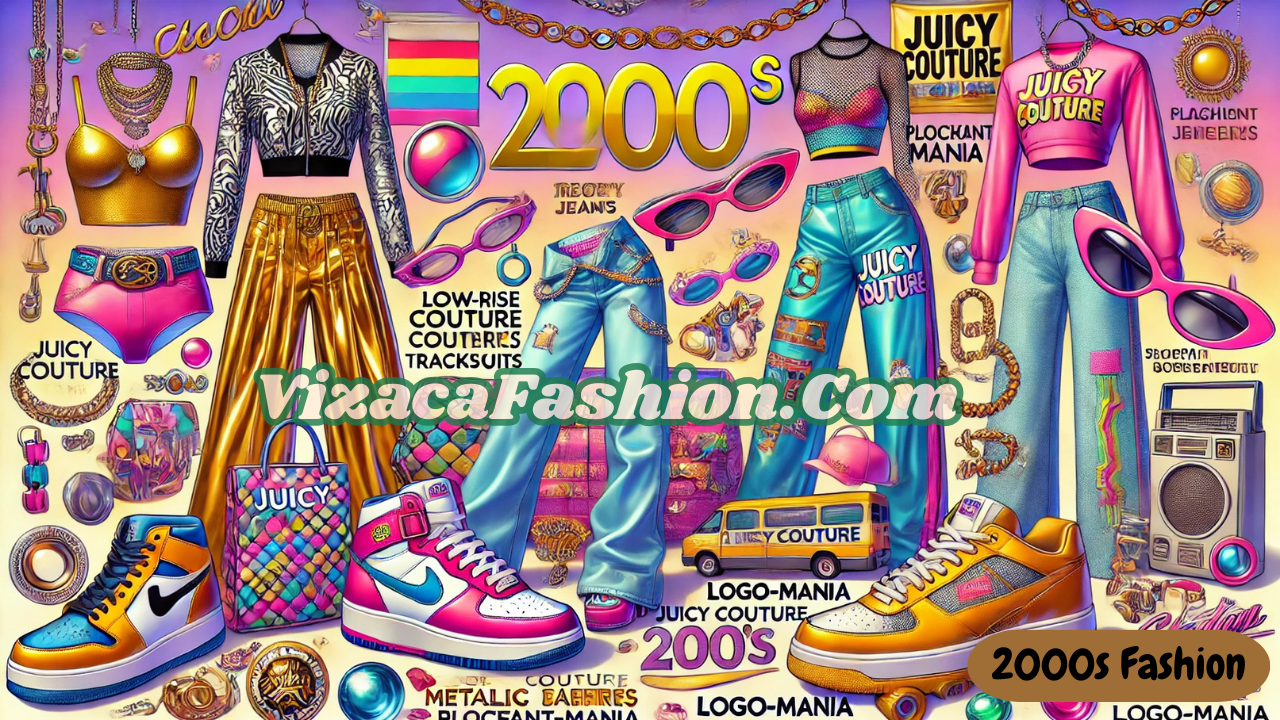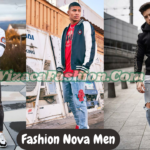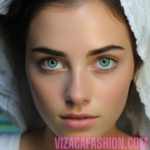The 2000s was a decade that blended a mix of fun, excess, and experimentation when it came to fashion. It was a time when style was often loud, bold, and unapologetically diverse. The fashion of the 2000s was shaped by a blend of celebrity influence, technological advancements, and the rise of fast fashion. This era saw iconic trends from the Y2K aesthetic to low-rise jeans, chunky belts, and logo-mania. Today, the 2000s fashion is experiencing a revival, as Gen Z embraces the nostalgic styles from the past. Let’s take a closer look at the fashion trends, key influences, and standout pieces that defined the 2000s.
The Y2K Aesthetic: The Beginning of the 2000s Fashion
The Y2K aesthetic, short for “Year 2000,” was the defining trend of early 2000s fashion. This period was marked by futuristic elements, metallic fabrics, and an almost cyber-punk approach to everyday dressing. The turn of the millennium also brought about a sense of uncertainty, with fears surrounding the Y2K bug—an issue where computer systems might crash due to the way dates were coded. Despite these anxieties, the fashion world embraced bright, shiny, and high-tech-inspired pieces.
Key trends within the Y2K aesthetic included metallic colors, holographic materials, and flashy designs. Think of silver halter tops, metallic skirts, and shiny pants, often paired with chunky, platform shoes. Logos were bold and in-your-face, with designers making their mark on everything from bags to jeans. Popular brands like Von Dutch, Juicy Couture, and Ed Hardy were synonymous with the Y2K look, creating clothing that screamed both luxury and irreverence.
Low-Rise Jeans: A Defining 2000s Trend
One of the most polarizing trends of the 2000s was undoubtedly low-rise jeans. These jeans were characterized by their low waistband, often sitting just above the hips or lower. The low-rise style became a hallmark of the decade, thanks to its prevalence in pop culture, particularly in the wardrobes of celebrities like Britney Spears, Paris Hilton, and Jennifer Lopez. The jeans were often paired with cropped tops, showcasing midriffs and belly-button piercings, creating a distinct look that defined the time.
The trend of low-rise jeans was divisive, with many people finding them uncomfortable or impractical. Still, for those who embraced them, they were a symbol of the carefree, party-driven culture of the 2000s. Denim styles ranged from baggy, distressed versions to the skintight, “painted-on” look, and the trend only seemed to grow in popularity as the decade progressed. Despite their controversial nature, low-rise jeans remain one of the most iconic elements of 2000s fashion.
Logomania: The Rise of Brand-Centric Fashion
The early 2000s was an era of excessive branding, with fashion enthusiasts flaunting recognizable logos on almost every piece of clothing. Known as logomania, this trend saw a huge rise in clothing that featured large, bold logos from top brands. This was particularly true with luxury labels such as Gucci, Louis Vuitton, and Fendi, as well as streetwear brands like Supreme and Tommy Hilfiger. Wearing clothing adorned with these logos signified a sense of wealth and status, and brands capitalized on the growing trend by making their logos even more prominent.
Logomania was seen across a wide range of fashion items, from T-shirts to bags and even hats. The logo craze wasn’t just reserved for high-end fashion, though. The mass-market was equally consumed with the trend, as fast-fashion giants such as Abercrombie & Fitch, Hollister, and American Eagle catered to a young crowd eager to display brand loyalty through their wardrobes.
In addition to obvious logos, many fashionistas took this trend to the extreme, opting for head-to-toe brand-themed outfits, like wearing a matching Fendi bag and scarf, or a Louis Vuitton tracksuit. This obsession with logo-centric fashion was a defining feature of 2000s style and is something that continues to influence contemporary fashion.
Streetwear and Hip-Hop Influence
Another key influence in 2000s fashion was streetwear, a style born from urban, skate, and hip-hop culture. As hip-hop grew in popularity, so did its impact on fashion. Brands like Rocawear, Sean John, and Phat Farm dominated the fashion scene, offering oversized hoodies, baggy jeans, and bold graphic tees. This street style was all about comfort and practicality, with an emphasis on sporty and casual clothing.
Baggy jeans, oversized jackets, and graphic T-shirts with slogans or logos became staples of the urban aesthetic. The fashion world also saw the rise of sneakers, particularly brands like Nike, Adidas, and Puma, which had a huge following among sneakerheads. Basketball jerseys, snapbacks, and chunky jewelry were other elements of hip-hop-influenced style, and these items were often seen in both casual streetwear and luxury designer collections.
Hip-hop stars like Jay-Z, Missy Elliott, and Kanye West (before his rise as a fashion designer) influenced much of what was worn on the streets. As hip-hop culture gained global prominence, so did the adoption of its fashion by young people all around the world.
The Return of Punk and Grunge Elements
While the early 2000s embraced shiny, futuristic fashion, there was also a nostalgic return to punk and grunge aesthetics, which had roots in the late 80s and early 90s. Bands like Nirvana, Green Day, and The Offspring had established a rebellious, anti-fashion vibe that many embraced in the 2000s. This led to the resurgence of elements like ripped jeans, band t-shirts, flannel shirts, and chunky combat boots.
However, the 2000s grunge look wasn’t just about the raw, unpolished style that the 90s represented. It was more polished and accessorized, with pieces such as plaid skirts, leather jackets, and even corsets making their way into the grunge-inspired wardrobe. The punk aesthetic was also adapted by the fashion world’s elite, with high-end designers like Vivienne Westwood and Marc Jacobs incorporating punk elements into their collections.
This reimagined grunge look became popular with figures like Avril Lavigne, who embodied the “skater girl” aesthetic, blending punk influences with youthful femininity.
Bold Accessories and Statement Pieces
The 2000s were all about making a statement, and accessories played a huge role in achieving that goal. Chunky, oversized jewelry was a hallmark of the time, from large hoop earrings to bold necklaces and bracelets. Plastic bangles, beaded chokers, and layered rings adorned wrists and fingers. Celebrities like Paris Hilton and Lindsay Lohan often sported these bold accessories, pairing them with their glamorous looks.
Alongside jewelry, handbags became a major statement piece. Iconic bags, such as the Louis Vuitton Speedy, Coach’s leather totes, and the Juicy Couture velour bag, became instant fashion symbols. The trend of carrying an “it” bag reached its peak in the 2000s, with many people eagerly trying to get their hands on the latest must-have item. Brightly colored, oversized sunglasses also made their mark during this period, often serving as an accessory that completed the larger-than-life looks of the 2000s.
The Revival of 2000s Fashion in Modern Times
As fashion often cycles, the 2000s aesthetic has seen a revival in recent years. With trends like low-rise jeans, chunky sneakers, and logo-heavy designs making a comeback, younger generations have embraced the nostalgia of 2000s fashion. Vintage shops and second-hand stores have become treasure troves for people seeking original pieces from the era, while fast fashion brands have jumped on the bandwagon, recreating iconic looks from the past.
The revival has been especially strong on social media, with influencers and celebrities reinterpreting the bold, experimental styles of the 2000s. It’s clear that while fashion evolves, there will always be a place for the bold, fun, and sometimes outrageous trends of the 2000s.
Conclusion: The Enduring Legacy of 2000s Fashion
The 2000s were a dynamic and vibrant time for fashion. From the Y2K aesthetic to the rise of streetwear, punk influences, and logo-mania, the decade saw an explosion of different styles and trends that helped define a generation. These trends continue to shape modern fashion, as younger generations rediscover and reimagine the bold, experimental spirit of the 2000s. Whether it’s through the return of low-rise jeans or the resurgence of chunky sneakers, 2000s fashion is far from forgotten, and its influence remains a significant part of the fashion world today.


